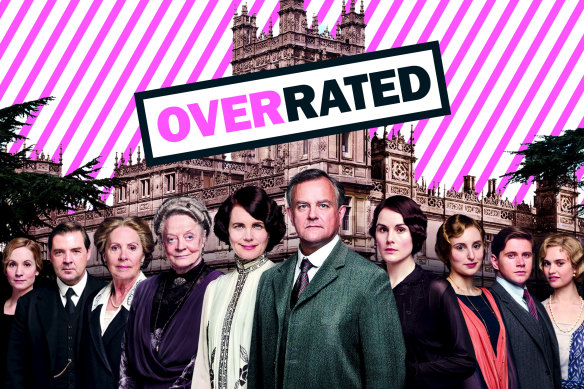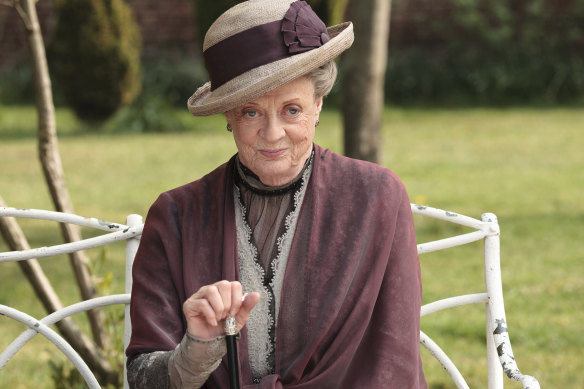This was published 3 years ago
Upstairs, Downstairs, who cares? Can we be done with Downton Abbey, please?
In this column, we will deliver hot (and cold) takes on pop culture, giving our verdict on whether a subject is overrated or underrated.
Ever since Downton Abbey made its way onto our screens in 2010, my grandmother has exclusively referred to the show as Down Town Abbey, which used to annoy me in the way people continually getting lyrics to famous songs wrong annoys me.
But having now endured all six tedious seasons of Downton Abbey and one equally tedious cinematic outing, I’m convinced Down Town Abbey sounds like a superior show.
Perhaps Down Town Abbey is about a working girl named Abbey who has to make ends meet downtown and finds herself swept up in a dangerous yet intoxicating world. Or it could be a gritty urban drama about a reformed criminal who finds salvation in prison. When he finally gets out, he decides to start a church in his old neighbourhood, his Down Town Abbey.

Give me a down town abbey over Downton Abbey any day.
Either way, both fictional premises sound more enticing than the actual premise of Downton Abbey, which, as far as I can tell, is basically this: wealthy English people sitting around a big house, waiting for other wealthy people to visit.
Despite the apparent limitations of this concept, credit must go to Downton Abbey creator Julian Fellowes for managing to squeeze so much out of so little.
Across six seasons totalling 52 episodes, critics and audiences fawned over Downton Abbey as if the show reinvented the wheel when it barely reinvented Pride and Prejudice. A grand estate occupied by a wealthy family with no male heirs … sound familiar? Never mind! Here’s an Emmy and a Globe for your troubles.

Me? Turn down a free villa? Unlikely.
But where Jane Austen created a world rich with layered characters and complex drama, Downton Abbey offered up a world layered with characters who are simply rich and dramatic.
Need proof? Allow me to share with you the synopsis of the new Downton movie (in cinemas this week), titled Downton Abbey: A New Era.
Plot: The Crawley family goes on a grand journey to the South of France to uncover the mystery of the Dowager Countess’s newly inherited villa.
That’s it; that is the entire plot. The Crawley family leaves their current house to holiday in the South of France at their new house.
Now I’m all for a work trip that doubles as a holiday, but even Julian Fellowes must’ve been a bit nervous when he pitched the idea to Universal. “So, the plan is to shoot on location in the French Riviera for six months.”
In typical Downton style, they attempt to inject as much pearl-clutching into this flimsy storyline as possible.
“Do sit down,” instructs the Dowager Countess (Maggie Smith) in the film’s trailer, as if this will be a challenge for the Crawley family, for whom sitting constitutes a hobby.
“I’ve come into possession of a villa in the south of Frah-nce,” she declares, before revealing that a former lover has passed away and bequeathed her the property, seemingly out of the blue.
The Verdicts
- Underrated: Thanks Apple, but we don’t need new emojis. The perfect option already exists
- Underrated: Agadoo’s fruit-fuelled hellscape is high art, and you can’t convince me otherwise
- Overrated: It’s time to dump Dumbledore
- Underrated: Shame on us, we didn’t know what we had until Sizzler was gone
- Underrated: These Good News Week duets deserve far more than YouTube obscurity
- Overrated: Don’t Chop the Dinosaur, Daddy is not even close to being a good ad
Colour the Crawleys shocked as news of this unexpected addition to their portfolio does the rounds. “You never thought to turn it down?” asks Lady Mary (Michelle Dockery), providing the Dowager Countess with an opportunity to do what she does best: patronise her loved ones. “Do I look as if I’d turn down a villa?”
You could possibly forgive Downton Abbey for turning such low stakes into a movie that runs over two hours if it were a one-off, but the show has a history of forcing us to care about problems that aren’t really problems at all.
Take the first film where the central conflict involved the King and Queen visiting Downton Abbey … so the house had to be really clean. That barely there plot line helped propel the movie to $194 million at the box office while maintaining an impressive 84 per cent rating on Rotten Tomatoes.
Admittedly, during the show’s six seasons on television, Downton Abbey occasionally strayed away from house-cleaning and house-inheriting to more substantial storylines. There was that time Lady Mary had sex with a Turkish diplomat until he perished in her bed, or when the family had a labrador called Isis (he also died), and of course, who can forget when the Earl of Grantham (Hugh Bonneville) famously projectile vomited blood all over some dinner guests (he lived).
But it is rather telling that for fans of Downton Abbey, Matthew’s death via car crash in season three, 10 whole years ago, remains the show’s high point.
“I’m still apologising to people now,” said Dan Stevens, the actor who played Matthew, in an interview with the Mirror in March 2017. “The way Matthew went was out of my hands, but it was rather shocking. There were some very upset people, and I’ve had to apologise to a lot of people.”
But Stevens has nothing to apologise for; he got out at the right time, saw the writing on the wall and drove through it. Instead, if the latest Downton Abbey iteration is anything to go by, it’s the rest of us who should be sorry.
A cultural guide to going out and loving your city. Sign up to our Culture Fix newsletter here.
To read more from Spectrum, visit our page here.